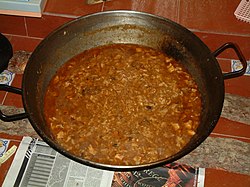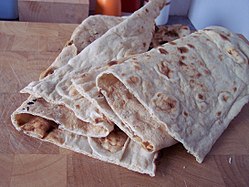This article needs additional citations for verification .(May 2016) |
 Gazpacho de Requena | |
| Alternative names | Torta gazpachera, gaspacho oranais |
|---|---|
| Type | Torta or flatbread |
| Place of origin | Spain |
| Main ingredients | Wheat flour |



Torta de gazpacho is a type of torta, or flat bread, used to prepare a dish called gazpacho or gazpacho manchego in La Mancha and Southeast Spain, including Murcia and parts of the autonomous community of Valencia. The word gazpacho comes from the Latin adjective caccabaceus, derived from caccabus ('cauldron'), attested in several works by Tertulian, Zeno of Verona and others. This word was applied in ancient Rome to a type of bread very similar to the torta de gazpacho. [1]
Contents
- Variants
- Castile-La Mancha
- Valencia
- Other places
- Gazpachos viudos
- See also
- References
- External links
A torta de gazpacho, also known as torta de pastor, is a flat and round bread made with wheat flour without yeast. Along with the gachas the tortas de gazpacho are a very ancient Iberian staple food preparation. Traditionally Manchega women used to bake their own tortas at home, but now a commercial type of torta de gazpacho is produced in La Roda under the name "torta cenceña".
To prepare gazpachos the flat bread is torn or cut into small pieces and mixed with a somewhat liquid stew in order to prepare a warm dish. This dish originated in the hearty food shepherds needed when they came back home on cold winter nights. It is traditional to serve this dish by placing the pan or large plate in the middle and all the guests sitting around eating from it. Sometimes instead of the plate the gazpacho is poured on a very large flat bread. [2]
This type of gazpacho should not be confused with the Andalusian cold soup also called gazpacho .
